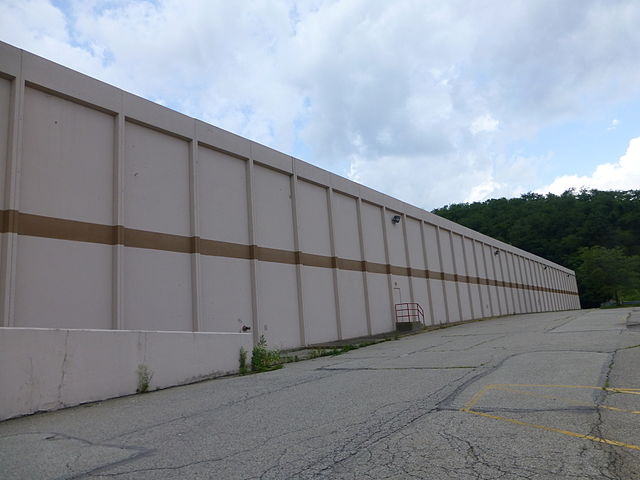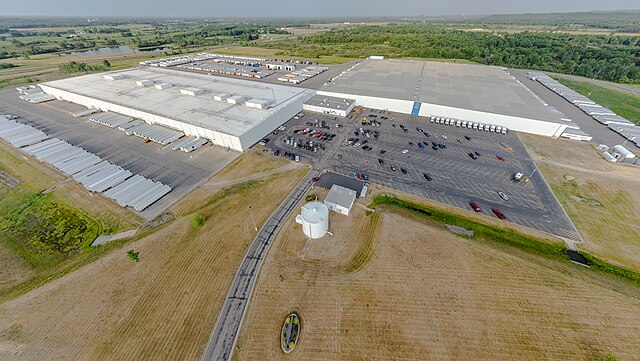PennFuture Blog
Our Perspectives on the Latest Issues
Updated Zoning Ordinances Are Vital to Addressing the Impacts of Today’s Logistics Industry
Like any law, zoning ordinances should be updated to reflect changes in society. One of the most significant changes impacting land use in Pennsylvania today is the rise of e-commerce and the massive logistics facilities that support it. As online shopping has become a major source of retail goods, industry practices have changed, and land development patterns have changed along with them. No longer the long-term-storage-based “warehouse” uses of the past, 21st century logistics facilities like distribution centers, fulfillment centers, and truck terminals are substantially larger, with an emphasis on rapid turnover of massive quantities of goods and materials.
Previous PennFuture blog, The True Cost of Convenience: The Impacts of Never-Ending Warehouse Development, discusses the driving forces behind this new pattern of development and the detrimental impacts that result. Distribution Centers Bring into Focus Limitations of Local Zoning Laws explores how Coolbaugh Township in Monroe County discovered the importance of well-crafted zoning ordinances in controlling the proliferation of logistics facilities in the Poconos and beyond. In this blog, we will look at a recently proposed zoning amendment in another Monroe County municipality that is hoping to get ahead of the massive influx of logistics facilities that threaten the health of our communities and our special protection waters.
Case Study – Jackson Township, Monroe County
Updated Definitions
Jackson Township has taken steps to update its zoning ordinance to address logistics uses. Its proposed ordinance, to be considered for approval at a public meeting on June 7, 2023, builds on lessons learned in Coolbaugh Township.
To begin, Jackson Township’s proposed ordinance includes clearer definitions of Warehouse and Distribution Center/Logistics Center. Where the existing ordinance defines a warehouse as “a building or group of buildings primarily used for the indoor storage, transfer and distribution of products and materials,” the proposed ordinance clarifies that a warehouse shall only consist of indoor storage of products and materials and cannot include “value-added” activities typical of distribution and fulfillment centers such as breaking down large orders into smaller orders, packaging, and order fulfillment. With this new definition, the proposed ordinance makes clear that any facility that goes beyond mere storage is not a warehouse.
In addition, where the existing ordinance treats all warehouses the same, regardless of size, the proposed ordinance recognizes that today’s warehouses are no longer exclusively small- to medium-sized facilities that can blend easily into a typical industrial or commercial area. Therefore, the proposed ordinance divides warehouses into two categories: Small Warehouses (up to 25,000 sq. ft.) and Large Warehouses (25,000 sq. ft. and above). Large Warehouses are subject to greater restrictions than Small Warehouses.
Jackson Township’s proposed ordinance also updates the definition of Distribution Center/Truck Terminal by strengthening the distinction between Distribution Centers/Truck Terminals and Warehouses. The proposed definition makes clear that value-added services, which are explicitly excluded from the definition of Warehouse, are one of the defining characteristics of a Distribution Center/Truck Terminal. The proposed ordinance also eliminates potentially-confusing language in the existing ordinance that allows a Warehouse to be “part of the operation” of a Distribution Center/Truck Terminal. In the proposed ordinance, these two uses are clearly distinct from one another.
Most significantly, the proposed ordinance treats any Large Warehouse that will generate more than 50 tractor-trailer trips in any 24-hour period as a Distribution Center/Truck Terminal. This is especially important because third-party developers often construct logistics facilities on speculation or “on spec.” This means the developer does not know who will occupy the facility when it is completed1. Developers can take advantage of this uncertainty by simply declaring that their facility is a storage-only Warehouse, not a Distribution Center/Truck Terminal offering value-added services. Without knowing who will ultimately occupy the building, municipalities and residents are forced to take developers at their word. Jackson Township’s 50-vehicle-trip trigger closes this loophole by linking regulation of the facility to an objective measurement that a developer must provide when applying for zoning approval.
Large Warehouses and Distribution Centers to Require Conditional Use Approval
Jackson Township’s new, more precise definitions allow the Township to craft additional zoning restrictions suited to the different types of uses.
For example, under the existing ordinance, Warehouses of any size are permitted as of right in the Township’s I-Industrial district. This means that any facility that meets the definition of a warehouse and complies with building size and setbacks requirements, even a 1 million square foot facility, could be built anywhere in the I-Industrial district without review or approval by the Board of Supervisors or public input as to whether the use is appropriate in that location.
The proposed ordinance changes this. Both Large and Small Warehouses are still limited to the I-Industrial district, but only Small Warehouses can be built without additional zoning review. Under the proposed ordinance, Large Warehouses are conditional uses, meaning that the Township Supervisors must review each proposed Large Warehouse to make sure it satisfies the specific requirements in the zoning ordinance. The Board of Supervisors must hold a public hearing and allow the public to weigh in on the proposal. This process also gives the Board of Supervisors an opportunity to impose conditions on approval, which is not possible with uses permitted by right.
The proposed ordinance also adds new, specific requirements that Large Warehouses must meet to obtain zoning approval from the Board of Supervisors. These requirements are related to the impacts generated by these massive facilities and include:
- A description of the nature and scale of on-site activities;
- A detailed description of potential environmental impacts;
- Evidence that the number of truck parking spaces will be adequate to accommodate expected demand; and
- A traffic study.
Under both the existing ordinance and the proposed ordinance, Distribution Centers/Truck Terminals are conditional uses in the I-Industrial district and are subject to the same review process. However, the proposed ordinance enhances the Township’s power to control Distribution Center/Truck Terminal by adding new requirements a developer must satisfy to obtain approval.
Under the existing ordinance, the only requirements for zoning approval of a Distribution Center/Truck Terminal are a 5-acre minimum lot size, a 100-foot setback from residential areas and a 50-foot setback from commercial areas. The proposed ordinance adds new requirements aimed at mitigating the impacts of these facilities, particularly traffic impacts.
These include:
- A 10-acre minimum lot size;
- A 150-foot setback between the facility and residential property lines;
- On-site stacking area for tractor-trailers;
- Prohibition against parking, loading and unloading on any public road;
- Amenities for the comfort, convenience and safety of truck drivers;
- A traffic study; and
- An environmental impact assessment.
PennFuture is pleased to see Jackson Township taking these steps toward a more comprehensive and effective ordinance that will enhance the Township’s ability to regulate logistics uses, and we support their amendment.
Possible Improvements to Better Protect High Quality Streams
Although Jackson Township’s proposed ordinance is a substantial improvement over its existing ordinance, there is some room to improve the ordinance to provide greater protection for special protection waters.
Several streams designated as High Quality waters by the Pennsylvania Department of Environmental Protection flow through Jackson Township’s I-Industrial zone. These waters are threatened by the vast amount of impervious surface that accompanies these uses. (See No More Pavement! The Problem of Impervious Surfaces for more information about the impacts of impervious coverage).
Municipalities should incorporate provisions into zoning ordinances to mitigate the detrimental impact of the impervious surfaces that come along with logistics uses. Possible options for Jackson Township include:
- Reduction in the amount of impervious surface permitted on a site.
- Incentives for use of impervious pavement.
- A requirement to minimize woodland disturbance. For more information about the role trees play in reducing stream degradation, see Penn State Extension’s article, The Role of Trees and Forests in Healthy Watersheds.
- 150-foot riparian buffers. For more information about the importance of riparian buffers, see the Pennsylvania Department of Environmental Protection’s Riparian Forest Buffer Guidance
These requirements would be appropriate for both Large Warehouses and Distribution Centers/Truck Terminals, as both have the potential to generate large amounts of impervious surface that triggers water quality concerns.
PennFuture Model Ordinance and Guidebook
PennFuture has taken the lessons from Coolbaugh Township, Jackson Township and other municipalities and distilled them into two forthcoming documents to assist municipalities in their efforts to better control and regulate logistics development. A Model Logistics Ordinance will provide municipalities with suggested definitions for logistics uses and other provisions aimed at mitigating the detrimental impacts of these uses. The accompanying Municipal Logistics Guidebook will explain PennFuture’s reasons for suggesting the Model Ordinance provisions and provide a road map to guide municipalities through the zoning and land development approval processes for these uses. Look for these resources from PennFuture later this summer!
Please support our efforts to protect our waters in the Poconos by becoming a member today!
<span class="EOP SCXW29216152 BCX0" data-ccp-props="{" 201341983":0,"335551550":6,"335551620":6,"335559739":120,"335559740":240}"="" style="margin: 0px; padding: 0px; user-select: text; -webkit-user-drag: none; -webkit-tap-highlight-color: transparent; font-size: 12pt; line-height: 19px; font-family: " times="" new="" roman",="" "times="" roman_embeddedfont",="" roman_msfontservice",="" serif;"="">
BLOG SEARCH
LATEST BLOG POSTS
Get the Latest onOur PennFuture
Sign up for email updates on the latest news, events, and opportunities to make a difference.

